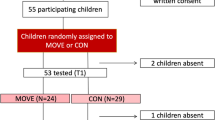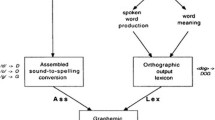Abstract
The purpose of this study is to investigate the effects of integrated mnemonics on consonant letter naming and consonant sound production for three 4th grade Turkish students, at-risk for failure in an English-as-a-Foreign-Language (EFL) classroom. Mnemonic picture cards, where the target consonant letter was embedded as an integral part of the picture, were developed (e.g., the letter C as the clock, the letter D as the drum). Results showed that (a) all three students reached mastery on consonant letter naming, and (b) all three students showed marked improvement for consonant sound production, with one student reaching mastery. Letter-sound correspondence performance remained near instructional levels one week post-intervention. Generalization data showed students could produce some words that began and ended with consonant sounds, once consonant letter-sound correspondence was mastered.
Similar content being viewed by others
References
Adams, M. J. (1990). Beginning to read: Thinking and learning about print. Cambridge, MA: MIT Press.
Agramonte, V., & Belfiore, P. J. (2002). Using mnemonics to increase early literacy Skills in urban kindergarten students. Journal of Behavioral Education, 11, 181–190.
Barlow, D. H., & Hersen, M. (1984). Single case experimental design: Strategies for studying behavior change. Boston: Allyn and Bacon.
Baer, D. R., & Templeton, S. (1998). Exploration in developmental spelling: Foundations for learning and teaching phonics, spelling, and vocabulary. The Reading Teacher, 53, 222–242.
Fulk, B. M., Loman, D., & Belfiore, P. J. (1997). Effects of integrated picture mnemonics on letter recognition and letter-sound acquisition of transitional first grade students with special needs. Learning Disability Quarterly, 20, 33–42.
Ganschow, L., & Sparks, R. (1995). Effects of direct instruction in phonology native skills and foreign language aptitude of at-risk foreign language learners. Journal of Learning Disabilities, 28, 107–120.
Gunn, B., Biglan, A., Smolkowski, K., & Ary, D. (2000). The efficacy of supplemental instruction in decoding skills for Hispanic and non-Hispanic students in early elementary school. The Journal of Special Education, 34, 90–103.
Jannuzi, C. (1998). Literacy Across Cultures: Key Concepts in FL Literacy: Phonemic Awareness. Available at http://www2.aasa.ac.jp/~dcdycus/LAC98/FEB98/PHONOWA1.HTM
Mastropieri, M. A., & Fulk, B. M. (1991). Teaching students ways to remember: Strategies for. Learning mnemonically. Cambridge: Brookline.
Mastropieri, M. A., & Scruggs, T. E. (1998). Constructing more meaningful relationships in the classroom: Mnemonic research into practice. Learning Disabilities Research and Practice, 13, 138–145.
Mastropieri, M. A., & Scruggs, T. E. (1991). Teaching students ways to remember: Strategies for. Learning mnemonically. Cambridge: Brookline.
National Research Panel. (2000). Teaching children to read: An evidence-based assessment of the scientific research literature on reading and its implications for reading instruction. Rockville, MD: National Institutes of Health.
Pressley, M., Levin, J. R., & Delaney, H. D. (1982). The mnemonic keyword strategy. Review of Educational Research, 52, 61–96.
Sari, H. (2000). Development of special education provision in Turkey: From the inclusive perspective. Presented at ISEC Congress, 2000. Available at: http://www.isec2000.org.uk/abstracts/papers_s/sari_1.htm
Scruggs, T. E., & Mastropieri, M. A. (1992). Classroom applications of mnemonic instruction: Acquisition, maintenance, and generalization. Exceptional Children, 58, 219–229.
Smith, S. B., Simmons, D. C., & Kameenui, E. J. (1998). Phonological awareness: Research bases. In D. C. Simmons & E. J. Kameenui (Eds.), What reading research tells us about children with diverse learning needs (pp. 61–128). Mahwah, NJ: Lawrence Erlbaum Associates.
Sparks, R., & Ganschow, L. (1991). Foreign language learning difficulties: Affective or native language aptitude differences. Modern Language Journals, 75, 3–16.
Stahl, S. A., Duffy-Hester, A. M., & Stahl, K. A. (1998). Everything you wanted to know about phonics (but where afraid to ask). Reading Research Quarterly, 33, 338–355.
The Ministry of National Education Report (MEB) (1997).T¨rkiye’de Ozel Eğitime Muhtac Cocuklar ve Eğitimleri.’ Ankara; The Ministry of National Education Publication.
Williams, J. (1995). Phonemic Awareness. In T. L. Harris & R. E. Hodges (Eds.), The literacy dictionary: The vocabulary of reading and writing (p. 185). Newark, DE: International Reading Association.
Author information
Authors and Affiliations
Corresponding author
Rights and permissions
About this article
Cite this article
Sener, U., Belfiore, P.J. Mnemonics Strategy Development: Improving Alphabetic Understanding In Turkish Students, At Risk for Failure in EFL Settings. J Behav Educ 14, 105–115 (2005). https://doi.org/10.1007/s10864-005-2705-x
Issue Date:
DOI: https://doi.org/10.1007/s10864-005-2705-x




